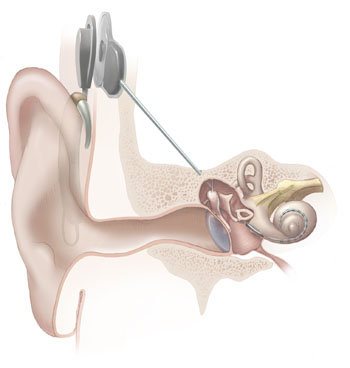Hören mit Cochleaimplantaten
 A cochlear implant (CI) is a surgically implanted electronic device that provides a sense of sound to a person who is profoundly deaf or severely hard of hearing. Cochlear implants are often referred to as a bionic ear.
A cochlear implant (CI) is a surgically implanted electronic device that provides a sense of sound to a person who is profoundly deaf or severely hard of hearing. Cochlear implants are often referred to as a bionic ear.
As of December 2012, approximately 324,000 people worldwide have received cochlear implants; in the U.S., roughly 58,600 adults and 38,000 children are recipients. Some recipients have bilateral implants to allow for stereo sound. However, barriers such as the cost of the device prevent many patients from acquiring the device.
Cochlear implants may help provide hearing in patients that are deaf due to lack of or damage to sensory hair cells in their cochlea. In those patients, they can often enable sufficient hearing to allow unaided understanding of speech. The quality of sound is different from natural hearing, with less sound information being received and processed by the brain. However, many patients are able to hear and understand speech and environmental sounds. Newer devices and processing strategies may allow recipients to hear better in noise, enjoy music, and even use their implant processors while swimming.
(Source: adapted from Wikipedia.org)
We decided to no longer make available our acoustic CI simulations as described in Goupell et al. (2008). The reason is that those simulations were based on pure envelope-based coding. It does, however, not take into account the coding of temporal fine structure as available with some newer CI systems and may therefore be misleading with respect to the percept available with such CI systems. We are currently working on an updated simulation model that takes into account the coding of temporal fine structure.
